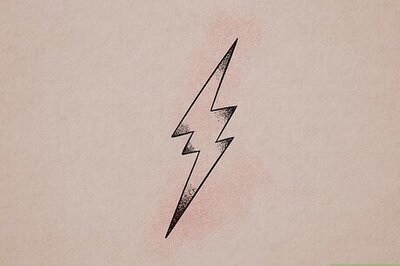
views
India’s southern neighbour Sri Lanka is in a crippling financial crisis, one that it has not seen since its independence. Fuel, food and all other essential commodities have run out in the island nation of 22 million people. Sri Lanka is now facing 13-hour long power cuts, disruption in public transport, inflation breaching 17% and the resultant widespread social unrest. Protests have been aimed at President Gotabaya Rajapaksa’s handling of the Sri Lankan economy since he took office in November 2019, and things have spiralled so uncontrollably that all 26 ministers of the cabinet have resigned and the ruling coalition has lost its majority in the parliament.
Is this enough to quell the public anger? Far from it. The problem is deep-rooted and there seems to be no end in sight. Sri Lanka is facing a twin deficit— its current account deficit has blown up and it is facing a budgeting shortage to finance imports any further. Forex reserves have dwindled by almost 70% in just two years to a mere $2 billion while Sri Lanka’s debt obligations for the year stand at $7 billion. In such a scenario, Sri Lankans can rest assured that their country will continue to face a debilitating shortage of essential goods with inflation expected to worsen in the coming months. The country has been downgraded significantly by credit rating agencies and its currency has been steeply devalued against the dollar which will in turn spur inflation further in an unsustainable vicious cycle.
How Did Sri Lanka Get Here?
Already not among the most fiscally sound economies of the Subcontinent, Sri Lanka’s finances received the death knell when Covid struck the world. For the tourism and remittance-driven economy, the worldwide lockdown erased a significant chunk of economic activity. Add to that the policies of the Rajapaksa government, which could not have come at a more terrible time.
Right after coming to power in November 2019, President Gotabaya abolished the “Nation-Building Tax” and slashed the VAT rate from 15% to 8%. The move also saw the removal of PAYE (Pay As You Earn), Withholding tax, Capital Gain tax and Bank Debit tax. This move was aimed at loosening up spending and boosting economic growth, but in a gross miscalculation, the Rajapaksa government overlooked the enormous debt obligations of the island nation. The seeds of the ballooning budget deficit were planted here amid already dwindling forex reserves.
Then in April 2021, the Sri Lankan government experimented with the food security of the nation and banned imports of chemical fertilisers to become the world’s first nation to farm organic only. This was a disastrous decision just from the looks of it and was opposed by farmers, but the government took six months to figure that out when it already had a failed crop in its hands. This triggered food inflation to the point that in August, the Rajapaksa government had to impose an economic emergency. It walked back on the ban later and sought aid from China and India. This was when Sri Lanka received tonnes of fertiliser from India and barred organic fertiliser from China over deadly bacterial contamination. In a nutshell, the disastrous move spurred inflation domestically and crushed Sri Lankan exports of tea and rubber and by the time it was rescinded, the damage was already done. The tea industry is a fine example— most of the tea crop failed last year in October dealing a huge blow to the nation’s exports.
Then came the Russia-Ukraine war which took rising oil prices to their peak this year. Sri Lanka failed to sustain fuel imports and this culminated in the situation we see today.
The Rajapaksa Factor
The Rajapaksas are no strangers to the economic perils of Sri Lanka. In fact, they have a deep hand in it. After putting an end to a 26-year-long civil war in 2009, Mahinda Rajapaksa was shunned by most of the world for human rights abuses during the war. This was when China deepened its reach in the Indian Ocean by splurging billions on the island nation, when no one would. Economic growth had already been on a decline when debt started growing, much of it being hard loans from China. In 2015, failing to sustain a portion of the debt, Sri Lanka leased the strategically crucial Hambantota port to China for 99 years. Sri Lanka fell hard into the Chinese debt trap, and the dangers of China’s predatory loans were realised globally. This was particularly bad news for India as the port will serve as a potential military base for the Chinese.
Also Read: With Lanka Burning, a Military Dictator Running Pakistan Will Only Compound India’s Challenges
The presidency of Mahinda Rajapaksa, currently the Prime Minister, was to blame for the entire fiasco. Apart from their strategy to profit from the India-China rivalry in the Indian Ocean and their failure to diversify exports, they have run the island nation as their family fiefdom. Three more Rajapaksas, apart from the duo of the Prime Minister and the President, helped keep the country’s governance in the family. Before the mass resignations, Basil Rajapaksa held the Finance Ministry, Namal Rajapaksa held the Youth and Sports portfolio and Chamal Rajapaksa held Irrigation.
Things took a turn for the worse for Sri Lanka when this family came to decide on whether to borrow more from capital markets or turn to China and India. Obviously, borrowing from the IMF comes with stringent requirements and audits, and therefore, they avoided turning to the IMF until just recently when sparks turned into fire.
Stop the flip-flops
The first challenge for Sri Lanka is to acquire loans that could rescue the near-bankrupt nation. It is in talks with the IMF for what would be the 17th bailout in 50 years. In this respect, Sri Lanka is only second to Pakistan. The second is to diversify exports and relax dependence on tea, rubber, and garment exports. And most importantly, Sri Lanka needs to stop indulging in hard loans from China while investing in projects that offer no palpable returns to the economy. While Sri Lanka’s foreign debt comprises 10% in Chinese loans compared to 40% in capital market debt, these are hard loans extended at interests rates of around 6% and are invested in projects that have only pushed the country into crippling debt without serving any gains.
Knowing full well that becoming China’s gateway into the Indian Ocean is not a tag to be proud of but to be gravely concerned about, not just because of India’s security concerns, but because Sri Lanka itself is no stranger to Chinese imperialism, the Rajapaksas have still shown a reckless affinity for expensive Chinese loans while expecting to be rescued by India. It’s a policy of flip-flops that needs immediate revision before more Sri Lankan territory falls into the hands of the Chinese.
India has been extending generous lines of credit, currency swaps and humanitarian aid to ease the pressure on the island nation. For India, it’s an opportunity to outpace China’s rising economic influence with growing soft power and perhaps even convince Sri Lanka to make better choices. Such a bilateral relationship, where the Sri Lankan leadership holds a knife to the country’s throat to wring bailouts from India is not a sustainable one in the long run and making decisions that threaten India’s own security in the IOR are no precedents to expect relief from New Delhi. It must be realised that it is now on the Sri Lankan leadership to make amends with a focus on long-term gains through policy changes, both domestic and diplomatic.
Read all the Latest Opinion News and Breaking News here



















Comments
0 comment